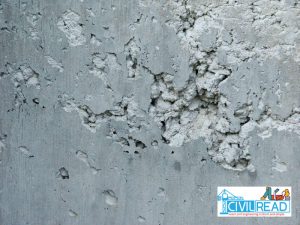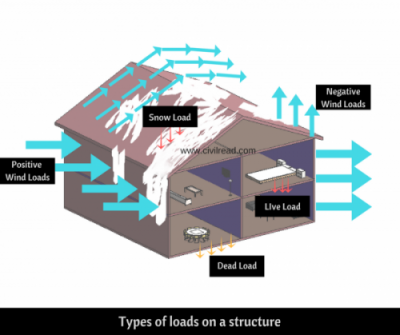Honey combing in Concrete:
Concrete is made into various structural elements such as Columns, Beams, Foundations, Slabs etc. as required as per the structural design When concrete is poured into the formwork, concrete starts flow like water sometimes cavities/voids are formed in concrete when concrete does not reach all places. It appears like honey bee nest. If it is not vibrated properly it may leave voids exposing the aggregate. Concrete Honeycomb not only reduces the strength also provides passage for water which in turn corrodes reinforcement bars. Corrosion is a process which continues through reinforcement rods even in good concrete, this result in loosing grip between rods and concrete, which is very dangerous to safety and life of concrete structures.
In other words, Honey comb refers to voids in concrete caused by the mortar not filling the spaces between the coarse aggregate particles.
Concrete Honeycomb is normally seen at the column and beam junction due to overcrowding of reinforcement bars which leads to poor concrete fill.

Causes of honeycombing in Concrete:
- Insufficient compaction to concrete.
- Less cover to reinforcement bars.
- Improper Workability in concrete
- Concrete already set before placing .
- High concrete free fall while pouring
- Form work not watertight/rigid.
- More coarse aggrgegates than designed mix proportions and over sized aggregates.
- Improper placement of bars at column and beam junction.
- Addition of more water than designed at site for achieving workability.
- Steel congestion not allowing concrete flow to all corner.
Remedies of Honeycombing in concrete:
- Concrete fall should be be kept minimum
- Use a mix with appropriate workability for the situation in which it is to be placed.
- Ensure the mix has sufficient fines to fill the voids between the coarse aggregate.
- Ensuring the concrete is fully compacted and placing methods minimise the risk of segregation.
- Ensure that the formwork is rigid, the joints are watertight and penetrations through the formwork, are properly sealed.
- At places of junction of columns and beams concrete with strictly 20mm and down aggregates should be used with slightly more water and cement to avoid honeycombs. Taping with wooden hammer the sides of shuttering from outs side during concreting and vibrating will help minimizing honeycombs to a great extent in case of columns and beams. Use of thinner needle say 25mm or less with vibrator at intricate places of concreting will also help in reducing honey combs to a great extent.
- Taping with wooden hammer on the sides of shuttering from outside during concreting will aid in minimizing honeycombs to a great extent.
Also Read:
Important properties of Concrete
Segregation and Bleeding in concrete




Super
Great
Nice job sir
Good job bro
Very nice Sir 👍
very useful information sir….sir, i have a question..as RCC is a mixture of concrete and steel, will the water in concrete effects the steel to corrode…
excess water affects concrete to segregate
after poring the concrete, or during the final setting time of concrete water in the concrete dehydrate itself. so it doesn’t effect the steel for further corrosive..
VERY NICE INFORMATION SIR. KEEP IT UP.
GOOD JOB SIR ., IT IS HELPFUL FOR ENGINEER
very nice sir all informations
V good.always send like its
If honey comb appears then what measure to safeguard the structure ??
Check the remidies buddy
Sir, Thank you very much for the very useful information regarding the concrete.
Great job
You have being really helpful,please keep up the good job.
Thanks for your words we have introduced forum for civil engineers you can join with us forum.civilread.com
which one is more stronger?
100 sq.ft. rcc slab
◆ concrete mixture made up with mixture machine or
◆concrete muxture made manually by labour
it depends on consistency machine made mixes with high accuracy makes concrete stronger
Thank you for your kind info you shared to us!! You know about BS 8110 in reinforced concrete design the material strengths, but limited to, are C30 and steel grade 460 and I am wondering once I get a position to the implement the project which mix ratio may I use to obtain C30.
Hello sir iam a fresher civil engineer .so I want gain all knowledge of construction at site so I request to if any group their means plz add me
Very helpful information keep up
Column size 1.2m*.75m. Height 3.2m
Cover 50mm.
Mainbar – 32mm , 32 now
Ring spacing – 100mm (each and every rod tie.)
How to avoid honycomb sir?
Kindly reply me.
Go through the article once again
Great job sir.